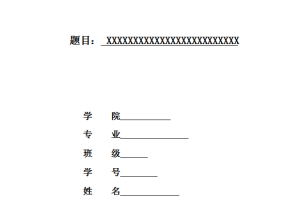Abstract
Computer Networks and the Internet have been growing rapidly in China. And they are bound to play a dominant role in all aspects of modern society including, of course, language education. This thesis is intended to elaborate on what is possible in English teaching when cyberspace has become a reality, compelling us to ponder on how it will change the way we teach and learn English, especially in traditional universities.
The thesis begins with an introductory chapter explaining the nature of the English language teaching (ELT) in China, the need and the significance of the study.
Chapter Two provides a brief historical review of technology and computer application in English teaching, explains what WBET is, briefly reviews the constructive theory which is the theoretical principle of WBET and goes on to discuss the different models which can be used in traditional universities. Compared with traditional classroom English teaching, WBET has its unique advantages.
Chapter Three serves as an introduction to Web-based aids by which the Web can be applied to English teaching and learning, giving many examples to illustrate currently available practical ideas as well as WBET’s rich potential in the immediate future.
Chapter Four, from another perspective, identifies ways in which Web-based technologies can contribute to the acquisition of the four basic language skills, e.g. listening, speaking, reading and writing.
Chapter Five discusses the challenges college teachers of English are confronted with, including funding, strong technical supporting and conditions required for the successful implementation of WBET.
Last but not least, Chapter Six summarizes the theme of the thesis and gives a clear-cut indication of the fact that WBET has a positive impact on English teaching and learning and that any institution of higher learning, be it college or university, will be playing a losing game if it neglects the application of the Internet to its educational programs. The writer also suggests in this chapter what future research is needed in this area.
内容提要
二十一世纪是网络世纪,飞速发展的因特网在政治、经济、文化、教育等方面发挥着重要作用,外语教学也不例外。结合作者的教学实践,本文阐析了在这一背景下如何将因特网和中国的大学外语教学相结合已到提高外语教学效果。
第一章首先简要阐述了英语教学在中国的性质以及本文研究的必要性和意义。
第二章回顾了科技,尤其是计算机在外语教学中的历史和发挥的重要作用。论述了网络英语教学的概念以及它在大学英语教学中的理论基础, 主要应用模式和独特优势。
第三章从因特网技术的角度出发, 分析了各种可以用于英语教学的网络工具的特点和使用方法。
第四章分析了如何利用网络帮助学生快速有效的掌握语言知识和听、说、读、写四种基本语言技能。
第五章分析了网络用于外语教学过程中可能会遇到的各种挑战,网络英语教学的局限性以及应对措施。
最后, 作为全文的总结,作者提出了在本领域有待继续研究的几个问题。同时指出,尽管网络用于外语教学有种种不足,不可能完全取代传统的课堂外语教学,但它外语教学有着积极的意义,是一种发展趋势。
Table of Contents
Acknowledgements…………………………………….…………..i
Abstract………………………………………………….………….ii
内容摘要……………………………………………….……….…. iv
- Introduction………………………………………………….…..1
1.1The Nature of ELT in China……………………………….…..1
1.2Need for the Study……………………………………………..4
1.3 Significance of the Study……………………………………….6
- Web-based English Teaching………………………………….9
2.1 Technology and Foreign Language Education……………,…9
2.2 History of Computer in English Teaching.………….………11
2.3 Constructivist Learning Theories……………………………..12
2.4 Models of WBET……………………………………………….15
2.4.1Web Support for Information Storage, Dissemination and Retrieval………………………………………..……….…….…15
2.4.2 Web Support for Two-Way Interaction……………….…..17
2.4.3 Full WBET…………………………………..…….…….17
2.5 Reasons for Using the Internet in English Classes……….…18
2.5.1Learnig to Use Computers Provides a Strong Intrinsic Motivation for Learning English.………………………………19
2.5.2 Internet Places English in an International Context. …..19
2.5.3 Internet Projects are Interactive. ………………………..…20
2.5.4Facilities for Using the Internet are Often Readily Available…20
2.5.5 Networked Computing Enables New Kinds of Learning…21
III. Applying the Web Aids for English Teaching…………………23
3.1 Electronic Communication………………….…………….…..23
3.1.1 Asynchronous Communication Tools…………………………24
3.1.2 Synchronous Communication Tools……………………..29
3.1.3 Virtual Communities……………………………………..30
3.2 Electronic Posting………………………………………..……31
3.2.1 Curriculum Course Documents Management……………31
3.2.2 Using Resources of Others………………………….…….33
3.3 Databases………………………………………………..…….34
3.4 Automated Test………………………………………….……35
- Language Acquisition With the Aid of the Internet……….…37
4.1 Teaching the Language System……………………….……..37
4.2 Acquiring the Language Skills………………………..…..38
4.2.1 Listening…………………………………………….……39
4.2.2 Speaking…………………………………………….……40
4.2.3 Reading………………………………………………..….40
4.2.4 Writing……………………………………………….……42
- Challenges and Weaknesses in WBET………………….……44
5.1 Overwhelming Amount of Information…………………….…44
5.2 Insufficient Funding…………………………………….……45
5.3 Security Issues…………………………………………….….45
5.4 Copyright and Plagiarism…………………………….……..47
- Suggestions for Future Research and Conclusions….……….49
Definition of Terms………………………………………….…..51
Endnotes………………………..………………..…………..…53
Bibliography………………………………………………………..55





